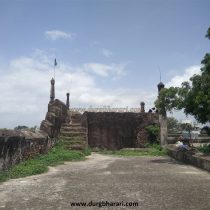AJANTHA SARAI
TYPE : SARAI
DISTRICT : AURANGABAD
GRADE : EASY
Ajantha is known for its world famous Ajanta Caves. The influence of these Ajantha caves on the tourists is so much that other historical monuments of this area are completely neglected before these caves. One of these monuments is the Ajantha fort of the Ajantha village itself and the Ajantha Nagarkot and the citadel of this fort Ajantha Gadhi (fortress). Ajantha is the central point connecting the important cities of Aurangabad-Jalgaon. This once flourishing city today retains its identity only because of the Ajantha Fort. About 95 km from Aurangabad, is Ajantha village, while coming from Jalgaon, and from Soygaon is about 15 km from fork. Above Ajantha Ghat is Ajantha village on the highway. Ajantha fort generally consists of two parts. One is Ajantha Nagarkot i.e. the ground fort surrounding the village (since Ajantha fort is a separate monument, detailed information about it is given on the Ajanta fort page.)
...
The second part is the fortress for the special people, i.e. for the royal family and soldiers, which is inside this ground fort but isolated from this ground fort at one separate end. This octagonal shaped fort is a part of Nagarkot and to avoid contact with the village, there is a separate water system for this fortress and there is a separate door for commute. Spread over approximately 5 acres, 8 bastions, two main gates, 2 sub-doors, fortifications and ramparts, stairways, arches and barns in the ramparts and other structures are still largely preserved in this fort. Built during the Mughal period, this fort is completely influenced by the Mughal style of architecture. On one side of this fort on the banks of the river Waghur, there was the river bed, on the other side the fortifications of Ajantha Fort and a trench on the land side, but now the trench is completely buried. On the way from Aurangabad, about one km from Ajantha village, the gate of Ajantha ground fort can be seen on the left. After entering the fort along this path, after passing a short distance, there is a porch (chauthara) on the left side. From here, the grand gate of Ajantha Fortress can be seen far to the right. If you go straight ahead through this path, you enter the Ajantha Fort through the main gate and there you will see another gate right in front of you. The gates of the fort are 25 feet high and four pillars can be seen on the four sides of the gate. Inside both the gates there are guard houses and barns are built in the ramparts. The wooden doors of both the grand entrances are still there and one can climb the ramparts of the fort by taking the stairs next to these doors. The entire ramparts are seen to be lined with battlements. The trench built around the village can be seen from this door. While circling the fort from the ramparts, one can see the inner ruins and a part of the fortifications of the Ajantha ground fort on the banks of the Waghur River. There are internal stairs at eight places to climb the ramparts but since six of them have been demolished, only two places can take you up to the ramparts. There is an old well inside the fort which is still in use today. Outside the second grand door of the fort there is an octagonal damaged Pushkarni and many Hindu relics can be found here. Next to this, in the cemetery at some distance, there is memorial of the famous Paro-Robert in the context of the Ajanta Caves. The history of this fort is unknown and the locals say that it was built during Aurangzeb's time, but the Pushkarni outside the Ajantha Fortress and the nearby Ajantha Caves suggest that it was inhabited before that. Ajanta Fortress can be easily seen after visiting Ajanta Caves. This fort, which bears witness to medieval construction, should be visited at least once before it falls into disrepair. At least two hours are needed to see Ajanta fortress and Ajanta Fort.
© Suresh Nimbalkar









